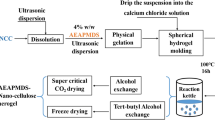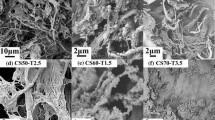Abstract
In this article, we reported a facile method for synthesizing poly (sodium acrylate) (PAANa)-modified TEMPO-oxidized cellulose nanofibril (TOCN) aerogel spheres. The water absorbent capacity of the spheres could be as high as 1030 g/g, which has never been reported before. Practically, the 1 wt% TOCN suspension was simply dropped into an HCl solution to prepare physically crosslinked TOCN hydrogel spheres. Afterwards, PAANa, an anionic monomer, was added into TOCN gel spheres by solution replacement, and the monomer was polymerized and grafted to the TOCN spheres in the presence of N,N-methylenebisacrylamide as a crosslinker through in situ free radical polymerization. The physical crosslinking (through hydrogen bonding) of the spheres was replaced by chemical crosslinking after washing the gel spheres to neutral, which resulted in high volume expansion (about 27 times v/v) of the washed sphere. The expansion rate and morphologies of the obtained hybrid gel spheres were strongly dependent on the dosage of the crosslinker and monomer. The structure and morphologies of the hybrid spheres were characterized by FTIR, TGA and SEM. The water-absorbing behaviors of the hybrid spheres were dependent on the pH, concentration of the salt solution and crosslinker content. The freeze-dried aerogel spheres were highly porous (approximately 99.88 %) with density as low as 1.5 mg/cm3. All results indicated that TOCN–PAANa hybrid aerogel spheres could serve as a new type of superabsorbent.







Similar content being viewed by others
References
Bao Y, Ma J, Li N (2011) Synthesis and swelling behaviors of sodium carboxymethyl cellulose-g-poly (AA-co-AM-co-AMPS)/MMT superabsorbent hydrogel. Carbohydr Polym 84:76–82
Brodin FW, Theliander HA (2013) Comparison of softwood and birch kraft pulp fibers as raw materials for production of TEMPO-oxidized pulp, MFC and superabsorbent foam. Cellulose 20:2825–2838
Cervin NT, Aulin C, Larsson PT (2012) Ultra porous nanocellulose aerogels as separation medium for mixtures of oil/water liquids. Cellulose 19:401–410
Chen W, Yu H, Li Q, Liu Y, Li J (2007) Ultralight and highly flexible aerogels with long cellulose I nanofibers. Soft Matter 7:10360–10368
Dadhaniya PV, Patel MP, Patel RG (2006) Swelling and dye adsorption study of novel superswelling [Acrylamide/N-vinylpyrrolidone/3(2-hydroxyethyl carbamoyl) acrylic acid] hydrogels. Polym Bull 57:21–31
Dai Q, Kadla JF (2009) Effect of nanofillers on carboxymethyl cellulose/hydroxyethyl cellulose hydrogels. J Appl Polym Sci 114:1664–1669
Egal M, Budtova T, Navard P (2007) Structure of aqueous solutions of microcrystalline cellulose/sodium hydroxide below 0 °C and the limit of cellulose dissolution. Biomacromolecules 8:2282–2287
Elazzouzi-Hafraoui S, Nishiyama Y, Putaux JL, Heux L, Dubreuil F, Rochas C (2008) The shape and size distribution of crystalline nanoparticles prepared by acid hydrolysis of native cellulose. Biomacromolecules 9:57–65
García-González CA, Alnaief M, Smirnova I (2011) Polysaccharide-based aerogels-promising biodegradable carriers for drug delivery systems. Carbohydr Polym 86:1425–1438
García-González CA, Jin M, Gerth J (2015) Polysaccharide-based aerogel microspheres for oral drug delivery. Carbohydr Polym 117:797–806
Huang YH, Lu J, Xiao CB (2007) Thermal and mechanical properties of cationic guar gum/poly(acrylic acid) hydrogel membranes. Polym Degrad Stab 92:1072–1081
Jiang F, Hsieh YL (2014) Amphiphilic superabsorbent cellulose nanofibril aerogels. J Mater Chem A 2:6337–6342
Lionetto F, Sannino A, Maffezzoli A (2005) Ultrasonic monitoring of the network formation in superabsorbent cellulose based hydrogels. Polymer 46:1796–1803
Liu N, Fu RW, Wang JB (2006) Studies on the energy storage performance of carbon aerogel spheres. Acta Scientiarum Naturalium Universitatis Sunyatseni 45:59–63
Liu Z, Miao Y, Wang Z, Yin G (2009) Synthesis and characterization of a novel super-absorbent based on chemically modified pulverized wheat straw and acrylic acid. Carbohydr Polym 77:131–135
Pourjava A, Barzegar S, Mahdavinia GR (2006) MBA-crosslinked Na–Alg/CMC as a smart full-polysaccharide superabsorbent hydrogels. Carbohydr Polym 66:386–395
Saito T, Kimura S, Nishiyama Y, Isogai A (2007) Cellulose nanofibers prepared by TEMPO-mediated oxidation of native cellulose. Biomacromolecules 8:2485–2491
Sehaqui H, Zhou Q, Berglund LA (2014) High-porosity aerogels of high specific surface area prepared from nanofibrillated cellulose (NFC). Compos Sci Technol 71:1593–1599
Silva TCF, Habibi Y, Colodette JL, Elder T, Lucia LAA (2012) fundamental investigation of the microarchitecture and mechanical properties of tempo-oxidized nanofibrillated cellulose (NFC)-based aerogels. Cellulose 19:1945–1956
Sim K, Youn HJ (2016) Preparation of porous sheets with high mechanical strength by the addition of cellulose nanofibrils. Cellulose 2016:1–10
Spagnol C, Rodrigues FHA, Pereira AGB, Fajardo AR, Rubia AF, Muniz EC (2012) Superabsorbent hydrogel nanocomposites based on starch-g-poly (sodium acrylate) matrix filled with cellulose nanowhiskers. Cellulose 19:1225–1237
Weeaver MQ, Montgomery RR, Miller LD, Sohns VE, Fanta GF, Doane WM (1977) A practical process for the preparation of super slurper, a starch-based polymer with a large capacity to absorb water. Starch-starke 29:413–422
Yang J, Zhao JJ, Han CR (2014) Tough nanocomposite hydrogels from cellulose nanocrystals/poly (acrylamide) clusters: influence of the charge density, aspect ratio and surface coating with PEG. Cellulose 21:541–551
Zhai T, Zheng Q, Cai Z (2016) Synthesis of polyvinyl alcohol/cellulose nanofibril hybrid aerogel microspheres and their use as oil/solvent superabsorbents. Carbohydr Polym 148:300–308
Zhang J, Li A, Wang A (2006) Synthesis and characterization of multifunctional poly (acrylic acid-co-acrylamide)/sodium humate superabsorbent composite. React Funct Polym 66:747–756
Zhang W, Zhang Y, Lu C, Deng Y (2014a) Aerogels from crosslinked cellulose nano/micro-fibrils and their fast shape recovery property in water. J Mater Chem 22:11642–11650
Zhang X, Lin Z, Chen B, Zhang W, Sharma S, Gu W, Deng Y (2014b) Solid-state flexible polyaniline/silver cellulose nanofibrils aerogel supercapacitors. J Power Sources 246:283–289
Zhang F, Wu W, Sharma S, Tong G, Deng Y (2015) Synthesis of cyclodextrin-functionalized cellulose nanofibril aerogel as a highly effective adsorbent for phenol pollutant removal. BioResources 10:7555–7568
Zhang F, Wu W, Zhang X, Meng X, Tong G, Deng Y (2016) Temperature-sensitive poly-NIPAm modified cellulose nanofibril cryogel microspheres for controlled drug release. Cellulose 23:415–425
Zhao Y, Fang L, Tan T (2014) Optimization of the preparation of a poly (aspartic acid) superabsorbent resin with response surface methodology. J Appl Polym Sci 38:2616–2622
Zheng Q, Cai Z, Gong S (2014) Green synthesis of polyvinyl alcohol (PVA)-cellulose nanofibril (CNF) hybrid aerogels and their use as superabsorbents. J Mater Chem A 2:3110–3118
Acknowledgments
These works were supported by the Doctorate Fellowship Foundation of Nanjing Forestry University and National Natural Science Foundation of China (31470593), and we thank The Priority Academic Program Development of Jiangsu Higher Education Institutions (PAPD) for the financial support.
Author information
Authors and Affiliations
Corresponding authors
Rights and permissions
About this article
Cite this article
Zhang, F., Ren, H., Tong, G. et al. Ultra-lightweight poly (sodium acrylate) modified TEMPO-oxidized cellulose nanofibril aerogel spheres and their superabsorbent properties. Cellulose 23, 3665–3676 (2016). https://doi.org/10.1007/s10570-016-1041-8
Received:
Accepted:
Published:
Issue Date:
DOI: https://doi.org/10.1007/s10570-016-1041-8




